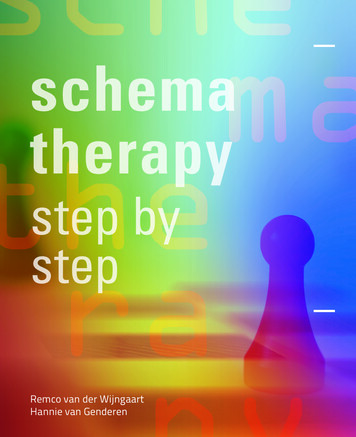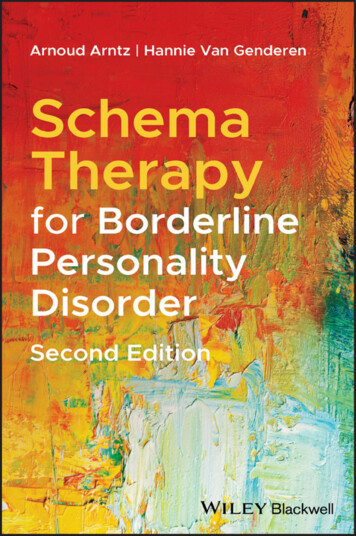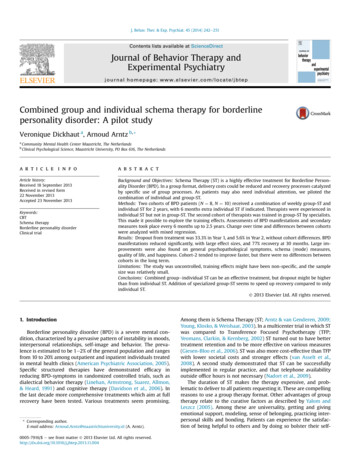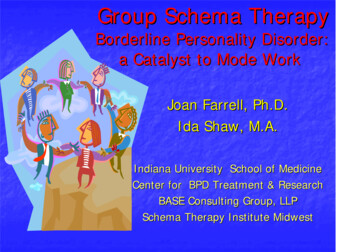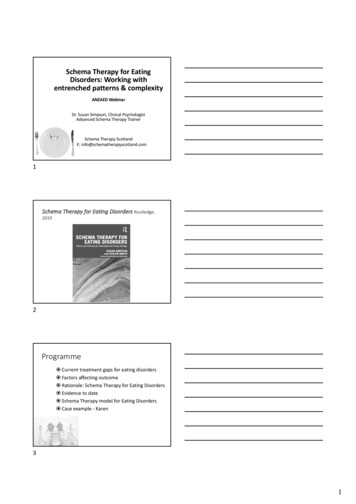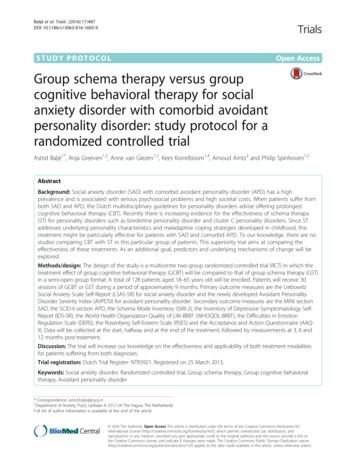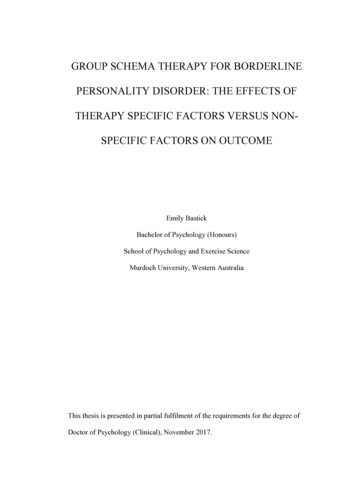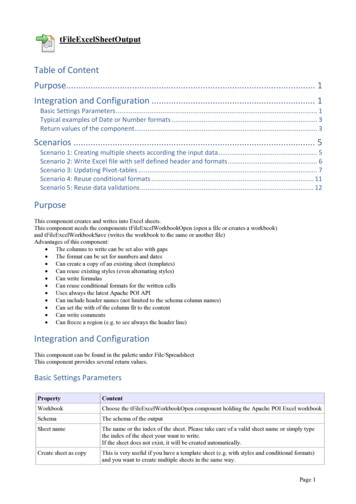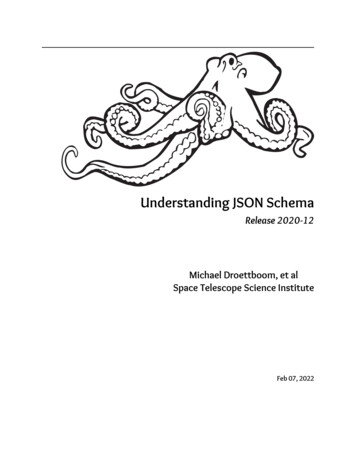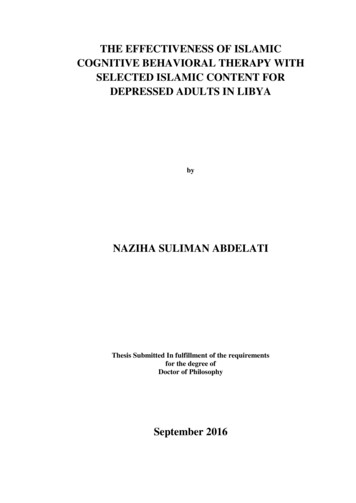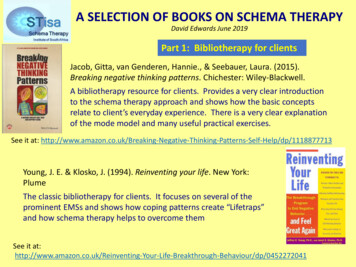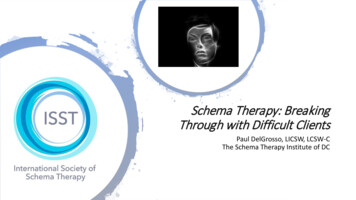
Transcription
Schema Therapy: BreakingThrough with Difficult ClientsPaul DelGrosso, LICSW, LCSW-CThe Schema Therapy Institute of DC
Schema Therapy“An Integrative, EvidenceBased Psychotherapy Modeloffering effective outcomeswith difficult treatmentpopulations”Founder: Dr. Jeffrey Young
Traits: EarlyMaladaptiveSchemas (EMS)“ broad, pervasive themes regarding oneselfand one's relationship with others, developedduring childhood and elaborated throughoutone's lifetime, and dysfunctional to asignificant degree."Activated under certain conditions andusually promoting intense affect, bodysensation, and self-defeating actions orinclinations “Conditions” that typicallymimic earlier experiences of frustratedunmet needs.Schema Therapy: A Practitioner's Guide, Jeff Young, et al.
Schema Modes: States A mode is the predominant state that we’re in at a given point intime (including our neurobiological state) Modes include whatever schemas, coping responses & healthyreactions are activated
EMS with Unmet Need Disconnection & RejectionEarly MaladaptiveSchemas (EMS):18 EMS organizedaround 5 corechildhood needsSafe attachment (protection, validation) Impaired Autonomy & PerformanceAutonomy (sense of identity, competence) Impaired LimitsRealistic limits (self-control) Other DirectednessFree expression (of needs and emotions) Overvigilance & InhibitionSpontaneity, playfulness
EMS (1)Disconnection & Rejectiono Abandonment/Instabilityo Mistrust/Abuseo Emotional Deprivationo Defectiveness/Shameo Social Isolation/AlienationImpaired Autonomy &Performanceo Dependence/Incompetenceo Vulnerability toHarm/Illnesso Enmeshment/UndevelopedSelfo Failure
EMS (2)Impaired LimitsoEntitlement/GrandiosityoInsufficient SelfControl/Self-DisciplineOther onoApprovalSeeking/RecognitionSeeking
EMS (3)Overvigilance & InhibitionoNegativity/PessimismoEmotional Punitiveness
Innate Child ModesoVulnerable Child, Angry Child,Impulsive ChildHealthy ModesoHappy Child, Healthy AdultModeCategoriesMaladaptive Coping ModesoOvercompensator, DetachedProtector, Compliant SurrendererDysfunctional Critic ModesoDemanding Critic, Punitive Critic
Schema formation.
Schemas: 5 domains, 18 EMSQuestions? Modes: 4 categories: Innate,Healthy, Maladaptive,Dysfunctional
Schema Therapy: Limited Reparenting (1)Limited Reparenting as both a therapist style and an intervention. Active ingredient of mode change work Provides corrective emotional experiences for unmet needs of the Childmodes, models healthy action to replace Maladaptive Coping modebehavior, and challenges negative internalizations of the Dysfunctional Criticmodes
SchemaTherapy:LimitedReparenting (2)“The behaviors of the schema therapistduring limited reparenting can besummed up as ‘doing what a GoodParent would do’ in meeting the client’sneeds within the bounds of aprofessional therapy relationship. Thismeans providing (1) protection,validation, and comfort for theVulnerable Child mode; (2) theopportunity to vent and be heard for theAngry Child mode; and (3) empathicconfrontation and limit setting for theImpulsive or Undisciplined Child mode.”-from Schema Therapy from the InsideOut, Farrell & Shaw
SchemaTherapy:LimitedReparenting (3)“The goal of limited reparenting is toestablish an active, supportive andgenuine relationship with the client thatprovides a safe environment in which theclient feels safe enough to be vulnerableand to express emotions and needs. Thetherapist’s provision of limitedreparenting in the psychotherapyrelationship fills critical gaps in emotionallearning in the form of secureattachment and accurate mirroring,which leads to the client feeling valuedand worthy, often for the first time.”-from Schema Therapy from the InsideOut, Farrell & Shaw
Schema Therapy: 3 stages of treatment"All three stages must be addressed, but their order will varybased on presenting problems, modes, needs, and the pace ofeach individual and therapist"-from Schema Therapy from the Inside Out, Farrell & Shaw
ST Stages: Bonding and Emotional Regulation Assessment, education, and understanding the presenting problemsin ST concepts Connecting with the Vulnerable Child Getting around or through the Maladaptive Coping modes Affect regulation and coping skills (if needed)from Schema Therapy from the Inside Out, Farrell & Shaw
ST Stages: Schema Mode Change Replacing Maladaptive Coping modes with adaptive choices Combating and challenging the Dysfunctional Critic modes Helping the Vulnerable Child mode heal through limited reparentingand corrective emotional experiences such as imagery rescripting Rechanneling the Angry and Impulsive Child into Healthy Adult actionfrom Schema Therapy from the Inside Out, Farrell & Shaw
ST Stages: Autonomy Development of the Healthy Adult mode and Happy Child mode andreliable access to these modes Individuation: following natural inclinations, pursuing activities thatare pleasurable and fulfilling, accepting the responsibilities of adultroles Developing healthy relationships Gradual termination of psychotherapy with the option of futurecontactfrom Schema Therapy from the Inside Out, Farrell & Shaw
Schema Therapy: AssessmentValidated Inventories:o Young Schema Questionnaire (YSQ L3 and YSQ S3)o Schema Mode Inventory (SMI)Other methods:o Imagery for Assessmento Also Young Parenting Inventory (YPI
Schema Therapy: Case ConceptualizationCase Conceptualization Form (Revised 2018)"Case conceptualization has a central place in schema therapy.This form is amajor development in schema therapy training and clinical practice. It willhelp clinicians provide a thorough Case Conceptualization that will increaseour understanding of the patients from a schema and mode perspective. Theimproved quality of the new Case Conceptualization form will aid in theselection and judicious use of schema therapy intervention strategies."-Joan Farrell
Questions? Limited reparenting: therapiststyle and an intervention Stages of treatment Assessment Case Conceptualization
Therapist Schema/ModeactivationST therapists must have astrong understanding of theirown schemas/modes and howthey get activated by differentpatients, presenting problems,and situations in sessions
Dealing with Our OwnSchemas & ModesImagery Exercise
ST conceptualization of BPD (1)Those with BPD have almost all 18 EMSMost prominent schemas:oAbandonmentoMistrust/AbuseoEmotional DeprivationoDefectiveness/ShameoInsufficient tionoPunitiveness
ST conceptualization of BPD (2)Because addressing each schema would be too timeunwieldy, mode work is essential in treating BPDFive main modes characterize typical patient with BPD:oAbandoned ChildoAngry and Impulsive ChildoPunitive ParentoDetached ProtectoroHealthy Adult
ST treatment of BPD (1)Viewing BPD patient as Vulnerable ChildOverall Treatment Objectives:o Emphasize with and protect the Abandoned Childo Help Abandoned Child to give and receive loveo Fight against, and expunge, the Punitive Parento Set limits on the behavior of the Angry and Impulsive Child andfoster ability to express emotions and needs appropriately-Jeff Young, Schema Therapy a Practitioners Guide
ST treatment of BPD (2)Treatment Strategieso Therapist-patient relationship (limited reparenting, HealthyAdult)o Experiential work (imagery exercises, mode dialogues)o Behavioral work (role plays, homework assignments)o Cognitive work (mode tracking form, audio flashcards)
Questions? Schema conceptualization ofBPD Treatment strategies
ST conceptualization of NPD (1)Like BPD, those with NPD often have many schemas and, as aresult, the mode-based approach is bestAlliance with the parts/modes that strive for health while.simultaneously fighting the maladaptive parts (those that movetoward isolation, self-destruction, and harming others)-Jeff Young, Schema Therapy a Practitioners Guide
ST conceptualization of NPD (2)Most prominent schemas with NPDo Emotional Deprivationo Defectiveness/Shameo Entitlement/Grandiosity
ST conceptualization of NPD (3)Other schemas frequently seen:o Mistrust/Abuseo Social Isolation/Alienationo Failureo Insufficient Self-Control/Self-Disciplineo Subjugation/Invalidationo Approval-Seeking/Recognition-Seekingo Unrelenting Standards/Hypercriticalnesso Punitiveness
ST conceptualization of NPD (4)Primary Modes:o Lonely Childo Self-Aggrandizero Detached Self-Soothero Healthy Adult
ST treatment of NPD (1)Primary Goals:o Build up Healthy Adult modeo Help Lonely Child feel nurtured and understoodo Confront Self-Aggrandizer (replace with reciprocity)o Help Detached Self-Soother give up addictive and avoidantbehaviors (replace with genuine love, self-expression,experiencing of affect)
ST treatment of NPD (2)Treatment Strategieso Therapist-patient relationship (empathic-confrontation, LonelyChild, model vulnerability, limit-setting, Healthy Adult)o Experiential work (imagery exercises, mode dialogues)o Behavioral work (role plays, homework assignments)o Cognitive work (mode tracking form, audio flashcards)
Questions? Schema conceptualization ofNPD Treatment strategies
ST Therapist Resources
ST Client Resources
Thank you for Listening!Paul DelGrosso, LICSW, .comISST Website: https://schematherapysociety.org/
Schema Therapy: Breaking Through with Difficult Clients Paul Del
